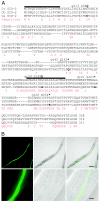Caenorhabditis elegans SID-2 is required for environmental RNA interference
- PMID: 17563372
- PMCID: PMC1965553
- DOI: 10.1073/pnas.0611282104
Caenorhabditis elegans SID-2 is required for environmental RNA interference
Abstract
In plants and in the nematode Caenorhabditis elegans, an RNAi signal can trigger gene silencing in cells distant from the site where silencing is initiated. In plants, this signal is known to be a form of dsRNA, and the signal is most likely a form of dsRNA in C. elegans as well. Furthermore, in C. elegans, dsRNA present in the environment or expressed in ingested bacteria is sufficient to trigger RNAi (environmental RNAi). Ingestion and soaking delivery of dsRNA has also been described for other invertebrates. Here we report the identification and characterization of SID-2, an intestinal luminal transmembrane protein required for environmental RNAi in C. elegans. SID-2, when expressed in the environmental RNAi defective species Caenorhabditis briggsae, confers environmental RNAi.
Conflict of interest statement
The authors declare no conflict of interest.
Figures




References
Publication types
MeSH terms
Substances
Associated data
- Actions
Grants and funding
LinkOut - more resources
Full Text Sources
Other Literature Sources
Molecular Biology Databases

